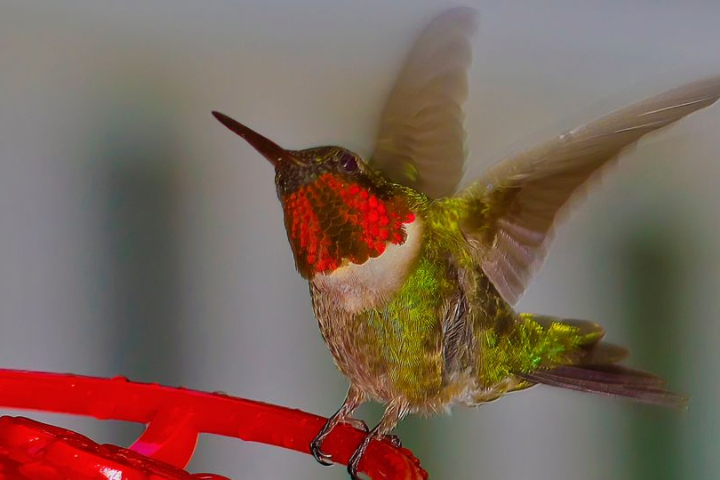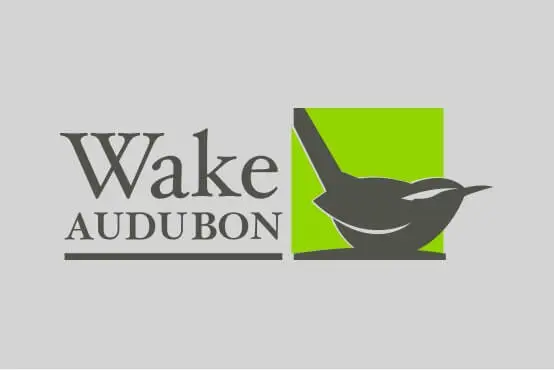- Home
- Conservation
- Bird of the Year
Bird of the Year
Each year Wake Audubon chooses a bird on which to focus. The species is always one that is found in Wake County and a bird that is under pressure from climate change, development and/or loss of habitat. We learn about the species through articles in our newsletter, lectures, and field trips. These entries were written by Brittany Richards.

Ruby-throated Hummingbird
Wake Audubon’s 2024 Bird of the Year
Goodbye. Hello! While this tiniest of feeder visitors may have bid backyards farewell months ago, Wake Audubon Society warmly welcomes as its 2024 Bird of the Year, Archilochus colubris: the ruby-throated hummingbird!
Even as the days grew shorter and pumpkins began appearing on porches, you replenished your nectar, just in case the emerald-backed and ruby-throated birds that enchanted you all summer needed a final sip of fuel before they began their long journey south. But as the maples and sweetgums turned crimson and gold, you realized your feeders had fallen silent, and you resigned yourself to the fact that even the last stragglers of the season had moved on, and you will have to await the ruby-throateds’ return in the spring.
But where will the birds who nipped nectar all summer in your yard spend their winter? As improbable as it may seem, these birds, with an average weight of just about 1/10 of an ounce – less than the weight of a single nickel – will travel thousands of miles to reach their wintering grounds in Central America (extending from southern Mexico, throughout the Yucatán Peninsula, to as far south as Panama). A smaller population of birds will stay along the tip of Florida and the southern Atlantic and Gulf coasts of the US to spend their winters stateside. So when our North Carolina days have become chilly and our flowers have all but disappeared for the season, the birds who flitted and fed around your yard all summer may be as far as 3,000 miles away enjoying a verdant, tropical winter.
Surprisingly little is known about the exact routes and duration of their migration, but research suggests that birds stopover throughout the Gulf coast, feeding and refueling for only a few days at most before continuing their journey to their final destination. It is believed that birds follow both an overland route, but also an overwater route that requires an 18-22 hour nonstop flight of 500 miles over the Gulf of Mexico. Just as amazingly, all ruby-throated hummingbirds make this trek alone, even first year migrants, who navigate on instinct alone without a parent to guide them. One study of ruby-throated hummingbirds showed that the southernmost birds of the summer range migrate first. So with our hummingbirds in North Carolina generally departing in late summer, those October feeder visitors very well may be birds from further north just passing through on their way south.
Though it was once feared that leaving feeders out too late in the fall would discourage hummingbirds from migrating, it is now known that this is a myth. It seems a combination of hormonal signals, the availability of natural food sources, and the decreasing amount of daylight triggers the migration instinct. So while it is certainly reasonable to store your feeder when it has been two weeks since your last sighting of a hummingbird, it will do no harm to leave it out longer. And in fact, should you decide to provide nectar all winter, you might even spot a visit from a so-called winter vagrant. Ruby-throated hummingbirds are the only species with a breeding range in the eastern United States, but with increasing frequency, species either beyond their typical range or birds overwintering between October 15 and March 15 can be spotted in North Carolina. In particular, eastern sightings of the western species, the rufous hummingbird, which usually winters in Mexico, are being seen at feeders in the southeast US. It is unknown if more birds are actually spending their winters outside their usual wintering grounds, or if more people are just monitoring their feeders throughout the winter and reporting these sightings. If you do spot a winter visitor, the North Carolina Museum of Natural Sciences has an ongoing project to track these vagrants, and you can report your own sighting on their website.
Most of us may not enjoy this jewel-toned wonder again until the coming spring, but Wake Audubon Society looks forward to celebrating and exploring the beautiful and fascinating ruby-throated hummingbird all year!
Photos by Robert Oberfelder unless otherwise indicated.
Bird of the Year Archives
- 2023 American Goldfinch
- 2022- Wood Thrush
- 2021-The Eastern Towhee
- 2020-The Red-headed Woodpecker
- 2019 – The Red-shouldered Hawk
- 2018 – The Brown Thrasher
- 2017 – The Grasshopper Sparrow
- 2016 – The Field Sparrow
- 2015 – The Chimney Swift
- 2014 – The Brown-headed Nuthatch
- 2013 – The Eastern Meadowlark
- 2011 and 2012 – The Chimney Swift
- 2010 – The Loggerhead Shrike
- 2009 – The Purple Martin
- 2008 – The Prothonatary Warbler


